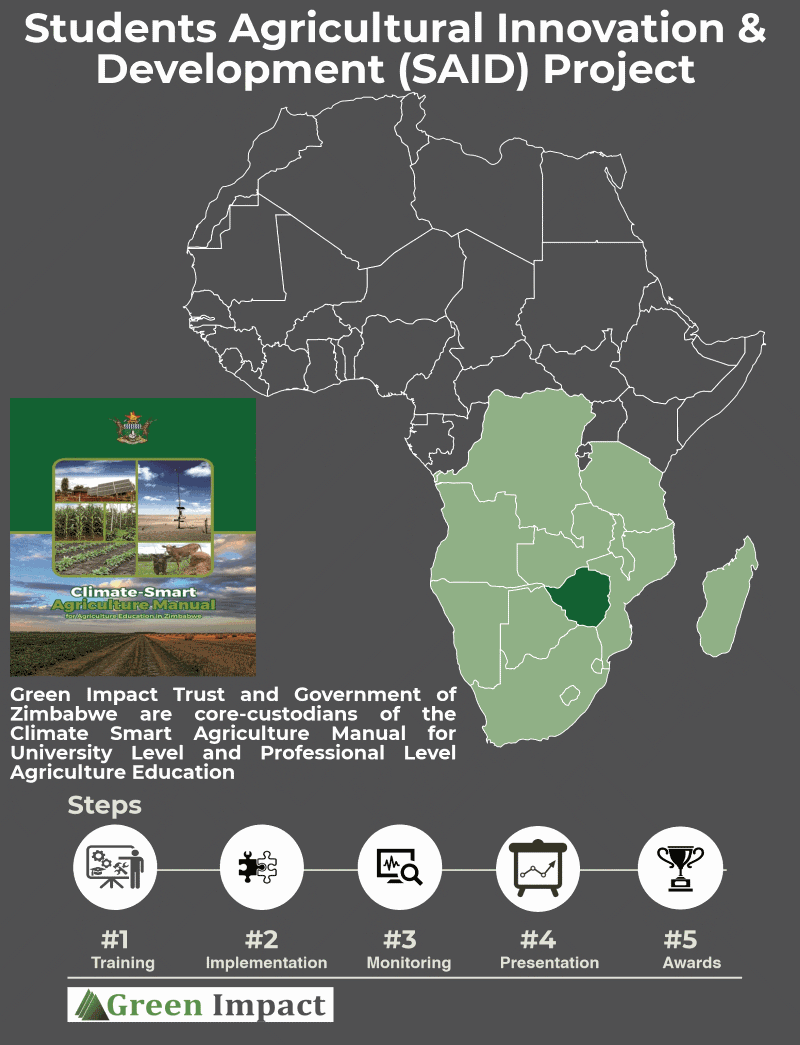Description
The Green Impact Trust established Students Agricultural Innovation and Development (SAID) teams in 8 public colleges of agriculture to implement climate-smart agriculture projects in farming communities. Each year, SAID teams receive training on climate-smart agriculture, utilizing the Climate Smart Agriculture Manual. Thereafter, students identify a need in a smallholder farm or/and a rural village, to be addressed by using climate-smart agriculture and innovative approaches. At the end of each year, SAID teams converge at an annual competition where they present their projects to an independent panel of judges through Oral Presentation, Project Report and an Exhibition Fair. Prizes and certificates are awarded to active students and winning projects.
The projects directly address challenges being faced in research, education, extension and industry sub-sectors in Zimbabwe’s agricultural economy. In November 2015, the Government of Zimbabwe submitted a request for technical assistance to the United Nations Framework Convention on Climate Change (UNFCCC) Climate Technology Centre and Network (CTCN), on behalf of the Green Impact Trust, to develop a Climate Smart Agriculture (CSA) Manual for University-level and professional-level agricultural education in Zimbabwe. The purpose of the CSA Manual is to increase capacity on climate resilience in colleges of agriculture, universities, extensions, professionals and the farming community of Zimbabwe.
The main partners to the UNFCCC CTCN Technical Assistance comprise the Climate Change Management Department in the Ministry of Environment, Water and Climate (MoEWC), which is the National Designated Entity (NDE) to the UNFCCC CTCN. Ministry of Agriculture, Mechanization and Irrigation Development (MoAMID) and Green Impact Trust are core-custodians to the CSA Manual.
The Climate Smart Agriculture Manual development for Agriculture Education in Zimbabwe is available at https://www.ctc-n.org/system/files/dossier/3b/climate-smart_agriculture_manual_final.pdf
Objectives and beneficiaries
OBJECTIVES:
1. Increase capacity in higher and tertiary institutions on climate change mitigation and adaptation technologies by mainstreaming climate-smart agriculture into the educational curriculum;
2. Develop higher and tertiary institutions as centers of excellence in the research, design and development of climate-smart technologies appropriate to the Zimbabwean context;
3. Engage with local and international learning institutions in promoting climate resilience by establishing an online forum, research and networking platforms;
4. Produce graduates whose skills, experience and exposure motivates them to establish innovative and cutting edge agricultural and entrepreneurial ventures in Zimbabwe;
5. Produce a cadre empowered with climate-smart extension and advisory services, able to support farmers to achieve productivity, adaptation and mitigation in a changing climate.
BENEFICIARIES:
Students in public and private colleges of agriculture, and out-of-school youths
Strong points of the solution
1. Increasing food and nutrition security;
2. Eradication of extreme poverty and hunger in mostly rural communities;
3. Developing students from colleges of agriculture and higher and tertiary institutions to provide climate-smart agriculture extension services;
4. Increase climate-smart agriculture adoption in smallholder farming communities, rural villages, and agricultural enterprises through training, monitoring and evaluation;
5. Reduce greenhouse gas emissions in on-farm activities through climate-smart agriculture training, water and energy management.
6. Increase crop and livestock productivity whilst reducing the cost of agricultural production;
7. Synthesis of information collected to improve on-farm agricultural production;
8. Build up a database on climate-smart agriculture coping mechanisms for use as models of best practice;
9. Improved transfer of knowledge by current extension workers in, mostly, smallholder farming communities across the country.
Expected results and benefits for climate change adaptation and mitigation
1. Increased energy and water efficiency in agricultural activities as 80% of the country's water consumption is from agriculture and agriculture is responsible for 40% of greenhouse gas emissions;
2. Increased uptake of renewable energy sources in agricultural activities, thus significantly reducing deforestation in Zimbabwe, which currently stands at over 300 0000 trees cut down annually;
3. Increased agricultural productivity through the introduction and promotion of climate-resilient crops and livestock varieties;
4. Restoration of degraded lands, soil fertility and grasslands due to climate-smart agriculture activities such as mixed farming, introducing legumes and organic fertilizer application, among other technologies;
5. Adoption of water harvesting technologies in farming communities as a measure to ensure water availability and access during dry seasons, which are becoming more frequent.
Scalability potential of the solution
1. Potential to be replicated at primary and secondary schools, and polytechnic and university levels in Zimbabwe, whose administration is under different government ministries;
2. Potential to extend the SAID project across other southern African countries as the region is expected to experience some of the worst impacts of climate change.
[Editor's Note: All information published as submitted by the author(s). Minor edits may have been made for length and clarity.]







